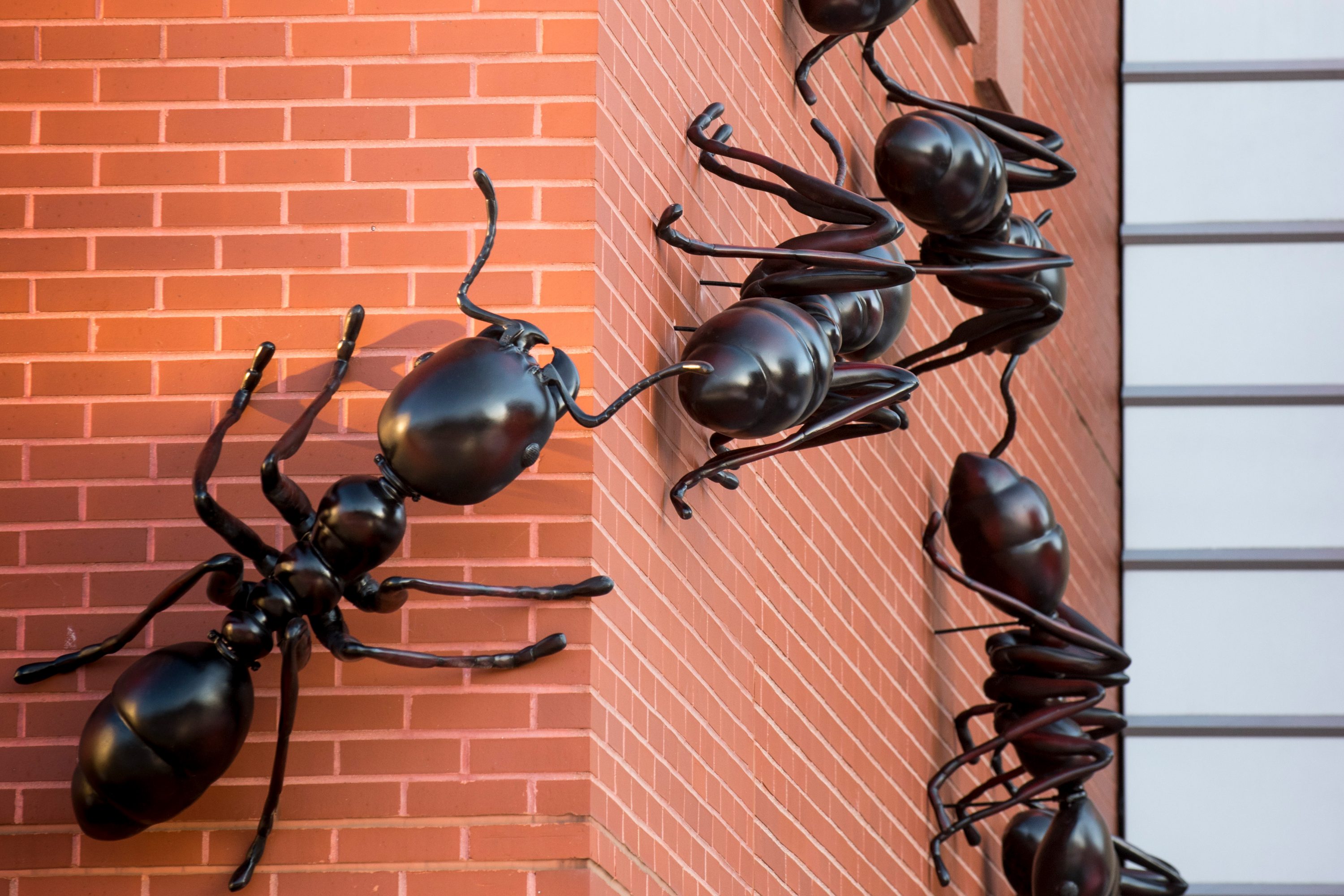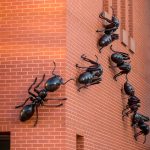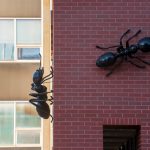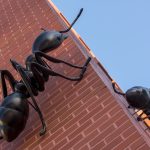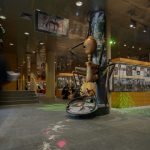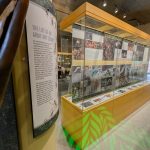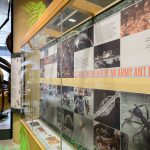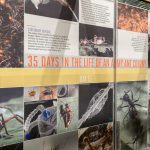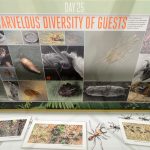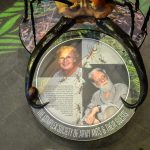
The seven four-foot ants crawling along the entrance to the Biology/Physics Building on North Eagleville Road are not a cause for alarm; instead, they invite visitors to follow them inside to view “Be Our Guest: An Exhibit on the Complex Society of Army Ants and Their Guests.”
The exhibit is the first public introduction to the Carl and Marian Rettenmeyer Army Ant Guest Collection, which is considered one of the premier collections of its kind in the world. It consists of more than two million specimens, field notes, and other material from research conducted by the late Carl Rettenmeyer, a faculty member in the Department of Ecology and Evolutionary Biology from 1971 to 1996, and his wife Marian. The exhibit opens to the public on Sunday, April 30 from 1 to 5 p.m., and continues Monday through Friday from 8 a.m. to 5 p.m.
The Rettenmeyers worked in Central and South America for 50 years studying the intricacies of the complex societies of army ants that are constantly foraging and moving along the ground, consuming up to 500,000 prey animals each day, such as earthworms, other insects, and larvae. Army ant societies are complemented by numerous “guests,” the many creatures, including mites, beetles, flies, wasps, springtails, and bristletails, that are intimately associated with the ants and benefit from their active daily life.
[The Rettenmeyers’] approach showed that what initially appeared to be a simple system was, in fact, fantastically complex. — Janine Caira
The exhibit is one of the initial results of a partnership between the Department of Ecology and Evolutionary Biology and the Connecticut State Museum of Natural History – which Carl Rettenmeyer founded – to curate, digitize, and catalogue the Rettenmeyer collection and its associated materials under a three-year, $500,000 grant from the National Science Foundation (NSF). In addition to hundreds of thousands of specimens of about 114 species of army ants, the collection includes 92,000 specimens of guests representing 187 species. The grant will also fund the development of an online database to provide researchers and the public with access to the various elements of the collection.
“This exhibit helps to fulfill one of the primary goals of the NSF grant, which is to make the Rettenmeyer collection available to the broader scientific community and to the general public,” says Janine Caira, Board of Trustees Distinguished Professor of Ecology and Evolutionary Biology. “The Rettenmeyers’ work teaches us that one needs to look carefully and closely if the wonders of the natural world are to be fully revealed. Their approach showed that what initially appeared to be a simple system was, in fact, fantastically complex. The challenge in developing an exhibit to share the wonders of their work and this system with visitors was one of scale. The majority of the guests are microscopic and many have evolved over time to resemble their ant hosts. Since we couldn’t scale visitors [to the exhibit] down, our solution was to scale the army ants and their guests up!”
Throughout the exhibit, visitors are encouraged to discover guests portrayed in a variety of ways. A 12-foot-tall model of an army ant soldier that welcomes visitors includes eight different cryptic mites attached to various parts of its body. Floor lighting of silhouettes of army ants and some of the guests that run with them in their emigration columns illustrate the remarkable resemblance between the ants and their beetle guests. Hundreds of photographs taken with light and scanning electron microscopes reveal the marvelous diversity and intimate associations of army ant guests. Visitors are invited to apply their new-found knowledge of this system to locate guests in a series of photographs of army ants in nature.
The lower portion of the display focuses on the highly diverse guests. Some have intimate associations with an individual ant, while others live among the throng of the colony. Army ants and their guests represent an astoundingly complex biological system. Together, these hundreds of species have coevolved over millennia to harness the rich resources of tropical rainforests.
The exhibit is a collaborative effort between NSF project personnel from the Department of Ecology and Evolutionary Biology, Caira, Jane O’Donnell, Geert Goemans, and Bernard Goffinet. Elizabeth Barbeau provided content for the exhibit, and Collin Harty, exhibit developer for the Connecticut State Museum of Natural History, designed and created the exhibit. The giant army ant with guests was created by Michael Anderson, chief exhibit preparatory at Yale Peabody Museum of Natural History and a noted sculptor. Michael Chybowski, associate professor of lighting design in the Department of Dramatic Arts, assisted with the strategy for displaying floor images.
For the opening of the exhibit, special programs will include a talk by UConn alumnus Rob Dunn ’03 Ph.D., professor of applied ecology at North Carolina State University, on his new book, Never Out of Season: How Having the Food We Want When We Want It Threatens Our Food Supply and our Future (Little Brown, 2017). There also will be a variety of activities including microscopes with real guest specimens, a tour of the Rettenmeyer Collection, a live fungus-growing ant colony, and special Dairy Bar AntU ice cream.
“Be Our Guest: An exhibit on the Complex Society of Army Ants and Their Guests” continues Monday through Friday from 8 a.m. to 5 p.m. at the Biology/Physics Building 91 N. Eagleville Road, Storrs, through 2019. For more information go to biodiversity.uconn.edu/ant-guests/. Parking is available in Lot 9 adjacent to the Lodewick Visitors Center and in the North Parking Garage, located at 103 North Eagleville Road. The lot and the garage are a short walking distance to the Biology/Physics Building.
Note: Beginning May 8, North Eagleville Road will undergo a major construction project, and will be a one-way street running west to east from Discovery Drive to Route 195 (Storrs Road) until late August.
